Single Mode Fluoride Fiber Optic Patch Cables
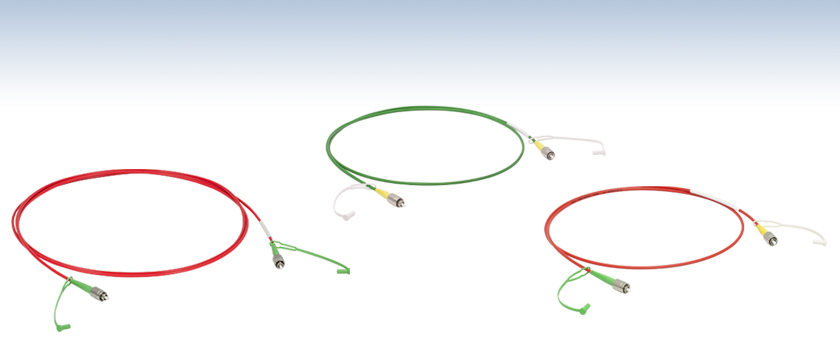
- SM Fluoride Patch Cables for 2.3 - 4.1 µm or 3.2 - 5.5 µm
- FC/PC- or FC/APC-Compatible Connectors
- Hybrid Cables (FC/PC to FC/APC) Available
- 1 m, 2 m, or 5 m Lengths
P3-23Z-FC-2
ZBLAN Fiber
FC/APC-Compatible Connectors
P1-32F-FC-1
InF3 Fiber
FC/PC-Compatible Connectors
P5-23Z-FC-1
ZBLAN Fiber
FC/PC- to FC/APC-Compatible Connectors

Please Wait
Applications
- Spectroscopy
- Fiber Lasers
- Supercontinuum Light Sources
- Environmental Monitoring
- Surgical Lasers
- Chemical Sensing
- IR Imaging
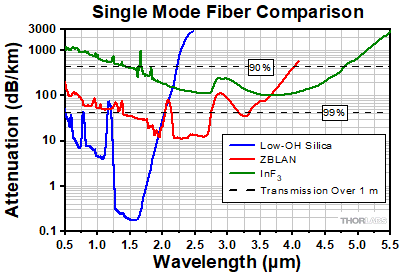
Click to Enlarge
Click for Raw Data
Figure 1.3 Compared to standard silica glass fibers, Thorlabs' single mode
fluoride fibers are transmissive at much longer wavelengths.
Features
- Patch Cables Using Fluoride Fibers Manufactured at Thorlabs' Fiber Draw Facility:
- Fluorozirconate (ZBLAN)† for 285 nm - 4.1 µm
- Fluoroindate (InF3) for 310 nm - 5.5 µm
- Single Mode Operation:
- 2.3 µm - 4.1 µm for ZBLAN
- 3.2 µm - 5.5 µm for InF3
- Compatible with Visible-Wavelength Alignment Beams
- Used in Spectroscopy, Environmental Sensing, and Medicine
- Low Fresnel Reflectance Losses: <4% per Face
Our single mode fluoride fiber patch cables are designed for low-loss transmission in the mid-IR spectral range. They incorporate Thorlabs' single mode fluoride optical fibers, which are manufactured in-house and have world-class purity, precision, and strength. For more information about fluoride glass and our manufacturing process, see the Manufacturing tab or our main fluoride fiber web presentation.
Fluoride fibers offer low attenuation in the mid-IR wavelength range, aided by an extremely low hydroxyl ion (OH) content. Our ZBLAN† (fluorozirconate) fiber patch cables are highly transmissive over the 285 nm - 4.1 µm range, with single mode operation from 2.3 µm to 4.1 µm. Our InF3 (fluoroindate) fiber patch cables are highly transmissive over the 310 nm - 5.5 µm range and exhibit single mode operation from 3.2 µm to 5.5 µm. Figure 1.3 shows how the wavelength-dependent attenuation compares to a fused silica fiber.

Click for Details
Figure 1.2 Each fluoride patch cable is labeled with its Item #, batch number, and key specifications.
Both ends of each cable are terminated using ceramic ferrule connectors, with flat or angled polishes that are compatible with either FC/PC- or FC/APC-terminated components, respectively (see the FC Connectors tab for more details). In setups that are sensitive to back reflections, we recommend using patch cables with angled connectors. Each cable includes two protective caps that shield the ferrule ends from dust and other hazards. Replacement CAPF (plastic) and CAPFM (metal) caps are available separately.
The refractive index of fluoride glass is near that of silica. As a result, optical fibers manufactured using fluoride glass exhibit low return losses and Fresnel reflections at both fiber-air and fiber-silica interfaces. Graphs of refractive index, numerical aperture (NA), and attenuation can be seen in the Graphs tab.
Since fluoride glass is softer than standard silica glass, extra care should be taken while cleaning and handling. See the Handling tab for suggested procedures.
Thorlabs also offers bare fluoride fiber and multimode fluoride patch cables. See the Fluoride Fibers and Components buttons for links to the main web presentation for each type of component.
† ZBLAN and ZrF4 are used interchangeably to refer to fluorozirconate glass.
Custom Fluoride Patch Cables
If our standard offerings do not meet your needs, please contact us to discuss customization. Some of the many customization options we provide for fluoride patch cables include:
- Custom Options: Fiber Type, Length, Termination, and Tubing
- OEM Patch Cables: Designed for Application Requirements
- AR-Coated Patch Cables
- Ruggedized Cabling for Harsh Environments
| Stocked SM Patch Cable Selection Guide | |
|---|---|
| Standard Silica Cables | FC/PC to FC/PC |
| FC/APC to FC/APC | |
| Hybrid | |
| AR-Coated Silica | |
| AR-Coated TEC Silica | |
| HR-Coated Silica | |
| Beamsplitter-Coated Silica | |
| MIR Fluoride Fiber | |
Fluoride Fibers and Components |
|||
 |
 |
 |
 |
 |
 |
 |
 |
| Item # Prefix | P1-23Z | P3-23Z | P5-23Z | P1-32F | P3-32F | P5-32F |
|---|---|---|---|---|---|---|
| Connector Compatibilitya | FC/PC | FC/APC | FC/PC to FC/APC | FC/PC | FC/APC | FC/PC to FC/APC |
| Jacket | FT030DF-R | FT030DF-G | ||||
| Bare Fiber Item # | IRZS23 | IRFS32 | ||||
| Fiber Type | Fluorozirconate (ZBLAN)b | Fluoroindate (InF3) | ||||
| Transmission Rangec | 285 nm - 4.1 µm | 310 nm - 5.5 µm | ||||
| SM Operating Wavelength | 2.3 - 4.1 µm | 3.2 - 5.5 µm | ||||
| Cutoff Wavelength | ≤2.3 µm | ≤3.2 µm | ||||
| Typical Attenuationd | 0.03 dB/m @ 2.5 µm | 0.15 dB/m @ 3.6 µm | ||||
| Maximum Attenuationd | <0.2 dB/m (from 2.3 to 3.6 µm) | <0.45 dB/m (from 3.2 to 4.6 µm) | ||||
| NAe | 0.19 ± 0.02 @ 2.0 µm | 0.26 ± 0.02 @ 2.0 µm | ||||
| Mode Field Diameterf | 10.5 ± 0.5 µm @ 2.5 µm | 11.0 ± 0.5 µm @ 3.6 µm | ||||
| Core Diameter | 9 ± 0.5 µm | |||||
| Cladding Diameter | 125 +1/-2 µm | |||||
| Core/Cladding Concentricity | ≤2 µm | |||||
| Core Circularity | ≥94% | |||||
| Long-Term Bend Radiusg | ≥30 mm | |||||
| Short-Term Bend Radiush | ≥10 mm | |||||
| Operating Temperature | -55 to 90 °C | |||||
This tab contains plots of the typical attenuation, bend-induced attenuation, mode field diameter, dispersion, numerical aperture, and core and cladding refractive indices of the single mode fluoride fibers that are used in our patch cables. Variations in these properties can occur between cables. Please contact Tech Sales to discuss whether these cables are appropriate for your application.
Attenuation
These graphs show the typical measured attenuation of our single mode fluoride fibers. The red shaded regions denote the range of single mode operation with guaranteed attenuation for each fiber, while the blue shaded regions denote the range of single mode operation without guaranteed attenuation. The peak just below the single mode cutoff wavelength is caused by attenuation of the second-order mode.
Bend-Induced Attenuation
This data was obtained by measuring the attenuation of a bend-free 1 m length of fiber, and comparing with the attenuation of the same length when a single loop with the given radius was added. These graphs show the additional attenuation introduced by the loop. The red shaded regions denote the range of single mode operation with guaranteed attenuation for each fiber, while the blue shaded regions denote the range of single mode operation without guaranteed attenuation.
Mode Field Diameter
These graphs show the typical mode field diameter of our single mode fluoride fibers, calculated from the measured core diameter and calculated numerical aperture of each fiber. The blue shaded regions denote the range of single mode operation for each fiber.
Dispersion
These graphs show the typical chromatic dispersion of our single mode fluoride fibers, calculated from the refractive indices. The blue shaded regions denote the range of single mode operation for each fiber.
Numerical Aperture
These graphs show the typical numerical aperture (NA) of our single mode fluoride fibers, calculated from the core and cladding refractive indices. The blue shaded regions denote the range of single mode operation for each fiber.
Refractive Indices
These graphs show the typical refractive indices of the core and cladding of our single mode fluoride fibers. The graphed data was obtained by fitting the Sellmeier equation to measured data. The Sellmeier equation and best-fit parameters for each fiber's core and cladding can be seen below each graph. The blue shaded regions in the graphs denote the range of single mode operation for each fiber.

Sellmeier Equation
| ZBLAN Sellmeier Coefficients | ||
|---|---|---|
| Coefficient | Core | Cladding |
| u0 | 0.5463 | 0.705674 |
| u1 | 0.7566 | 0.515736 |
| u2 | 1.782 | 2.204519 |
| u3 | 0.000 | 0.087503 |
| u4 | 0.116 | 0.087505 |
| u5 | 21.263 | 23.80739 |
| A | 0.9562 | 1 |
| InF3 Sellmeier Coefficients | ||
|---|---|---|
| Coefficient | Core | Cladding |
| u0 | 0.47627338 | 0.68462594 |
| u1 | 0.76936893 | 0.4952746 |
| u2 | 5.01835497 | 1.4841315 |
| u3 | 0.0179549 | 0.0680833 |
| u4 | 0.11865093 | 0.11054856 |
| u5 | 43.64545759 | 24.4391868 |
| A | 1 | 1 |
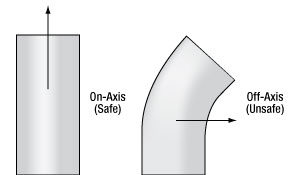
Click to Enlarge
Figure 4.1 This diagram compares on-axis tension, which can be safely applied, to off-axis tension, which can induce unsafe curvature and damage the fiber.
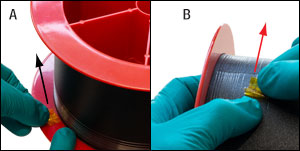
Click to Enlarge
Figure 4.2 The recommended procedure for removing tape from the bare fiber spools is shown in this image. The tape should be pulled parallel to the fiber when removing, while the other hand applies gentle force to stabilize the fiber.
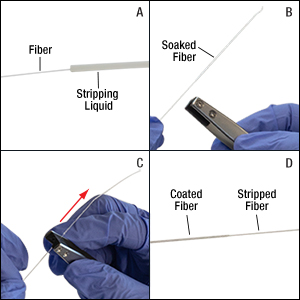
Click to Enlarge
Figure 4.3 These images depict the recommended stripping procedure.
A: Immerse the target fiber section in stripping liquid.
B-C: Gently pinch the base of the soaked section with FSGT tweezers and pull toward the end of the fiber.
D: The coating should slide off, leaving a stripped section.
The material properties of fluoride glass differ from those of silica glass. This tab details recommended handling procedures for our fluoride fibers and patch cables.
Safety and Disposal
ZBLAN and InF3 glasses may present health risks. Information about the composition of our fluoride fibers is available from Tech Support upon request. When handling bare, stripped fluoride fiber, chemically resistant gloves such as our nitrile gloves should always be worn. Fiber shards generated from cleaving should be disposed of in a sharps container such as our FTDU fiber optic disposal unit.
Thorlabs will accept and dispose of any fluoride fiber or filled disposal units that you wish to discard. Please contact Tech Support before returning fiber or filled disposal units. If you wish to dispose of fiber locally, please follow all applicable local laws and regulations.
Storage
Because fluoride glass is softer than silica glass, exposed end faces are easily scratched during storage, and care should be taken to ensure that they are not exposed to mechanical abrasion. Storage under normal lab temperatures and humidities will not affect the integrity of the fiber. Prolonged, direct contact with liquid water or water vapor should be avoided.
Bending and Tension
Fluoride fiber is strong in tension, but can break easily if forces are applied off-axis or if it is bent to a small radius. These fibers should never be bent to smaller than their short-term bend radii. Moderate on-axis forces can be safely applied to the fiber, such as tension applied during spooling. Figure 4.1 demonstrates safe on-axis tension and unsafe off-axis tension.
Our bare fluoride fibers ship on a spool, with their ends taped to the spool body. When removing the fiber, the tape should be pulled parallel to the fiber, as shown in Figure 4.2.
For protection, our fluoride patch cables are jacketed with PVDF furcation tubing or stainless steel tubing that is stiffer than the jackets used in typical patch cables. As long as the jacket is not forced to bend below its specified minimum radius, the fiber will remain intact. For out patch cables with PVDF jackets, the tubing will become discolored if the bending limit is exceeded. Our patch cables with stainless steel tubing are designed so that the tubing mechanically limits the fiber to be unable to bend below its minimum radius.
Stripping
Fluoride fibers are susceptible to damage when conventional mechanical stripping techniques are used, owing to the softness of the glass. Our FSGT Coating Stripping Tweezers can be used along with a chemical stripping agent to effectively strip these fibers without scratching or nicking the cladding.
To strip a fiber, the coating should first be exposed to a stripping liquid such as a paint stripper for three to five minutes. Placing the stripping liquid in a long vessel such as a syringe with a long tip is recommended to increase ease of application. If using a gel-type stripper, it can be applied manually to the exterior of the fiber. Note that the required soaking time will depend on the particuar stripping agent being used as well as the chemical composition of the coating. For example, if a dicholomethane (DCM) based stripping liquid is used, the required time may be shorter.
The coating on the section of the fiber soaked in stripping liquid will visibly swell, as seen in section B of Figure 4.3. A pair of FSGT tweezers can then be used to gently pinch the fiber in the soaked section, and pull toward the end of the fiber. Care should be taken to ensure that only moderate pressure is applied, or else the fiber may break. The soaked coating should slide off the end of the fiber, leaving the cladding exposed. If residue remains on the stripped section, it can be cleaned as detailed below.
Refer to any safety documentation for the chemical stripping agent before use.
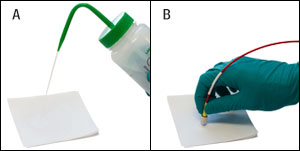
Click to Enlarge
Figure 4.4 These images depict the recommended procedure for cleaning end faces with a solvent.
A: Wet a stack of five or more TCW604 wipes with an appropriate solvent (see the text for examples).
B: Gently pass the fiber end face across the wet wipe.
Cleaning
Because fluoride glass is soft, end faces and stripped sections of our fluoride fibers and patch cables can be easily scratched during cleaning. If particulates are present on the glass surface, first try to remove them using compressed air. If compressed air is insufficient, then an appropriate solvent can be used with our TCW604 TechniCloth®† Lint-Free Wipes to clean the tip, as shown in Figure 4.4. Methanol and isopropanol are examples of appropriate solvents, while acetone is unsuitable. Wiping with a dry cloth is not recommended as it may scratch the surface.
Please note that Kimwipes®†† are extremely likely to scratch the fiber tip and should not be used.
Cleaving
Our fluoride fibers can be cleaved using a tension-and-scribe cleaver such as our Vytran® LDC401 large-diameter fiber cleaver. Note that cleaving these fibers may generate shards. Safety glasses and chemically resistant gloves should always be worn when cleaving.
†TechniCloth® is a registered trademark of the Illinois Tool Works, Inc. Corporation.
††Kimwipes® is a registered trademark of the Kimberly-Clark Corporation.

Figure 5.3 Angled
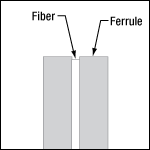
Figure 5.2 FC-Terminated Fluoride Patch Cables have Flat-Polished Tips
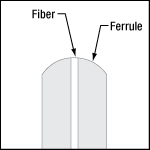
Figure 5.1 Standard FC/PC Connectors have Domed Tips
When using standard silica fiber patch cables, FC/PC or FC/APC connectors are typically chosen because the PC and APC polishes provide domed tips that bring the cores of two mated patch cables into physical contact. This physical contact minimizes the connection loss at the cable-to-cable interface.
Since fluoride glass is softer than silica glass, the polishing procedures used for silica glass result in flat fiber tips. Depending upon the cable, the tip may also be slightly recessed with respect to the ferrule. Fluoride patch cable connectors are therefore neither FC/PC (where "PC" denotes Physical Contact) nor FC/APC (where "APC" denotes Angled Physical Contact). Hence, we denote these cables as either flat-polished FC or angle-polished FC.
The flat fiber tip does not affect applications where the fiber output is being coupled into free space. However, when making cable-to-cable connections with FC connectors, such as through a mating sleeve or a bulkhead, transmission losses can occur because the fiber cores may not be in physical contact. Because the gap between FC-terminated cables is smaller than the typical gap between SMA905-terminated cables (which use air-gap ferrules), these losses are usually negligible.
Figures 5.4 and 5.5 show two- and three-dimensional representations of the tip of a finished fluoride patch cable.
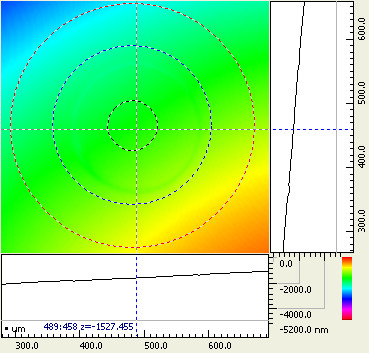
Click to Enlarge
Figure 5.4 This image contains a two-dimensional surface profile of the tip of a Ø100 µm core, flat-polished FC fluoride patch cable. The X and Y axis units are displayed in microns. The dashed circles and lines are shown as a guide to the eye. The interface between the metal ferrule and the cable interior is visualized by a faint green circle inside the blue dashed circle. This data is representative of all our flat-polished FC fluoride fiber patch cables.
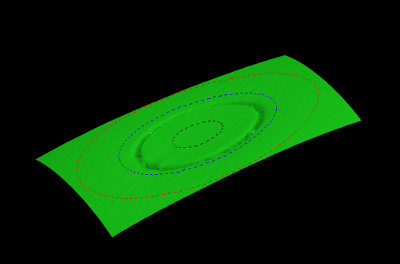
Click to Enlarge
Figure 5.5 This image contains a three-dimensional map of the tip of a Ø100 µm core, flat-polished FC fluoride patch cable. The dashed circles are shown as a guide to the eye. The interface between the metal ferrule and the cable interior is represented by the round depression between the black and blue circles. This data is representative of all our flat-polished FC fluoride fiber patch cables.
Thanks to their operation in the mid-IR wavelength range, these single mode fluoride fiber patch cables are ideal for a variety of applications that are unsuitable for silica fibers. Such applications include mid-IR spectroscopy, chemical sensing, and environmental monitoring, as well as mid-IR fiber lasers and supercontinuum light sources.
Usage Recommendations
Since fluoride glass is softer than standard silica glass, extra care should be taken when cleaning these patch cables. Please see the Handling tab for fluoride-fiber-specific usage tips. Compared to unterminated fiber, the maximum power that these cables can withstand is limited by the connectors.
Example Application: Interband Cascade Lasers
Because the SM operation range overlaps with the emission range of our Interband Cascade Lasers (ICLs), low-loss measurements of the laser output spectrum are possible using these cables in combination with our Optical Spectrum Analyzers. Because fluoride glass transmits down into the UV, visible light (such as that generated by fiber-coupled lasers) can be propagated along the same fiber as an alignment aid. Note that because visible light is below the cutoff wavelength, it will propagate as if in a multimode fiber.
Coupling
Many of Thorlabs' collimators and couplers are compatible with these patch cables, depending on the application and the wavelength of light being used. Two examples are shown in Figures 6.1 and 6.2.
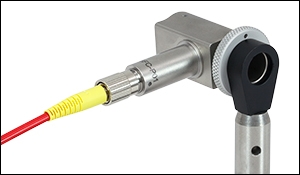
Click to Enlarge
Figure 6.1 Signals in SM fluoride patch cables can be coupled into free space using a reflective collimator.
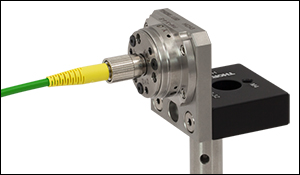
Click to Enlarge
Figure 6.2 As an alternative to reflective collimators, our FiberPorts offer free-space coupling with five degrees of freedom, plus rotational adjustment.

Click to Enlarge
Figure 75A The left image shows the intensity profile of the beam propagated through the fiber overlaid on the fiber itself. The right image shows the standard intensity profile of the beam propagated through the fiber with the MFD and core diameter called out.
Definition of the Mode Field Diameter
The mode field diameter (MFD) is one measure of the beam width of light propagating in a single mode fiber. It is a function of wavelength, core radius, and the refractive indices of the core and cladding. While much of the light in an optical fiber is trapped within the fiber core, a small fraction propagates in the cladding. The light can be approximated as a Gaussian power distribution as shown in Figure 75A, where the MFD is the diameter at which the optical power is reduced to 1/e2 from its peak level.
Measurement of MFD
The measurement of MFD is accomplished by the Variable Aperture Method in the Far Field (VAMFF). An aperture is placed in the far field of the fiber output, and the intensity is measured. As successively smaller apertures are placed in the beam, the intensity levels are measured for each aperture; the data can then be plotted as power vs. the sine of the aperture half-angle (or the numerical aperture for an SM fiber).
The MFD is then determined using Petermann's second definition, which is a mathematical model that does not assume a specific shape of power distribution. The MFD in the near field can be determined from this far-field measurement using the Hankel Transform.
Video 8.1 View our recorded webinar, in which we highlight our manufacturing techniques, the history of fluoride fiber R&D, and the state of fluoride fiber technology today and in the future.
Thorlabs manufactures ZBLAN zirconium fluoride (ZrF4) and indium fluoride (InF3) fibers at our vertically integrated fiber draw facility. The facility handles raw materials, glass preforms, fiber draw, and patch cable production, all in the same location. By controlling the process from start to finish, Thorlabs can ensure fibers consistently meet world-class specifications, including low attenuation, high mechanical strength, and precise geometry control.
The facility, located in Newton, NJ, USA, is well-equipped for high-volume manufacturing and is capable of producing many kilometers of fiber with consistent performance. In addition, because the fiber stays within Thorlabs' facilities from start to finish, the manufacturing process can be adjusted to accommodate unique custom orders or R&D needs.
Fluoride Characteristics
Fluoride fibers are ideal for transmission in the mid-IR wavelength range, and Thorlabs' fibers feature low attenuation over this range as a result of stringent manufacturing processes yielding an extremely low hydroxyl ion (OH) content. Fluoride fibers also have lower refractive indices and lower chromatic dispersion when compared to other fibers that offer transmission in the mid-IR range, such as chalcogenide glass fibers. Thorlabs' tightly controlled processes mitigate scattering and point defects in the fiber, as well as eliminate micro-crystallization in the glass matrix.
Fluoride Fiber Characterization and Testing
In addition to manufacturing fiber, Thorlabs offers testing and characterization services for our fiber products. We precisely measure the properties of each drawn fiber to ensure that it meets our high standards of quality. Extensive testing also provides feedback for our fiber draw team, enabling tight control of each step in the manufacturing process. Customers can request custom testing of any Thorlabs-manufactured fiber, which is then provided with the shipped fiber. Testing of third-party fiber samples provided by customers is also available upon request.
Available tests and services include:
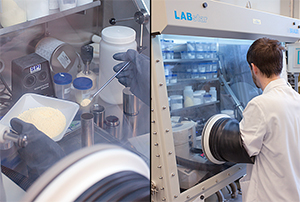
Click to Enlarge
Figure 8.3 A Thorlabs engineer mixes raw materials in our fluoride glass fabrication facility.
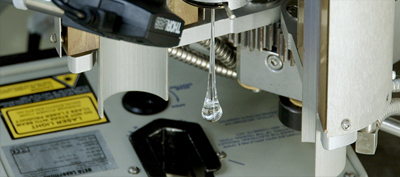
Click to Enlarge
Figure 8.2 A Glass Drop During the Fiber Draw Process
- Spectral Attenuation Measurement
- UV / Visible / NIR / MIR Wavelength Range
- SM or MM Fiber and Bulk Glass
- SM Fiber Cutoff Wavelength Measurement
- Fiber NA Measurement
- Fiber Glass / Coating Geometry Measurement
with Sub-µm Accuracy - MIR High-Power Screening for MM Fibers
- Fiber Tensile Strength Testing
- Defect / Break Analysis
- Degree of Cure Testing for Fiber Coatings
Request testing for Thorlabs or third-party fibers by
contacting Tech Sales.

Click to Enlarge
Figure 8.4 This graph shows Thorlabs' steady improvement in the average attenuation of all ZBLAN fiber draws during the given year.
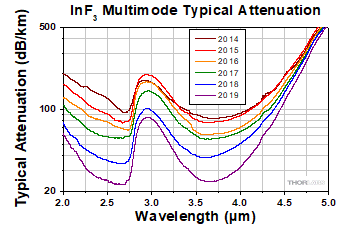
Click to Enlarge
Figure 8.5 This graph shows Thorlabs' steady improvement in the average attenuation of all InF3 fiber draws during the given year.
Technical Team
Thorlabs' team of MIR fiber researchers and engineers has many years of experience in fluoride glass research and development, production, and fiber draw. Their knowledge and expertise have resulted in consistent improvement in the quality of our fluoride fiber. See Figures 8.4 and 8.5 for the progression of our fluoride fiber performance.
Custom Fluoride Fiber and Patch Cables
If our standard offerings do not meet your needs, please contact Tech Support to discuss customization and potential fiber draws. Some of the many customization options we provide for fluoride fibers and patch cables include:
Bare Fiber
|
Patch Cables
|
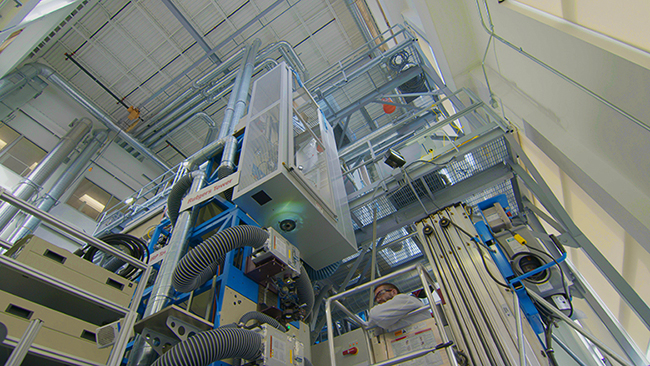
Click to Enlarge
Figure 8.6 Thorlabs' Fiber Draw Tower
| Posted Comments: | |
user
(posted 2019-05-29 15:08:54.13) What is the refractive index of the core and the cladding of the fiber? YLohia
(posted 2019-05-30 02:42:04.0) Hello, this information is given in the "Graphs" tab of this page. hometown
(posted 2018-10-13 10:58:45.34) Does these fibers have fiber jackets? What's the diameter? Can it be compatible with polarizer controller CPC250 or CPC900 for mid-IR polarization control?
Thanks,
Hongtao Lin
hometown@mit.edu YLohia
(posted 2018-10-15 11:21:39.0) Hello Hongtao, the P1-23Z-FC-1 has a Ø3 mm Red PVDF, which is shown in the specs table. Unfortunately, neither of those are compatible with 3mm jackets. We do not offer these fibers in smaller tubing diameters since these fibers are very sensitive and prone to damage. david.panak
(posted 2016-05-10 09:57:13.54) i have part P1-23Z-FC-2 and it works very well for my application.
Could you please quote a version of P1-23Z-FC-0.3 (0.3m long) that is armor jacketed?
Need a bend radius capability of approximately 4cm for the armored fiber.
thanks
David Panak
L-3 MID besembeson
(posted 2016-05-10 04:49:24.0) Response from Bweh at Thorlabs USA: Yes we can provide this to you. I will follow-up via email. spearrin
(posted 2016-03-23 19:32:52.433) Hello, would it be possible to get your InF3 single mode fibers in a bundle for IR endoscopy? Please email me. Thanks besembeson
(posted 2016-03-24 03:53:02.0) Response from Bweh at Thorlabs USA: We do provide several custom fiber configurations like this one. I will contact you for your full requirements. besembeson
(posted 2015-10-15 11:15:08.0) Response from Bweh at Thorlabs USA: The fiber transmission rapidly approaches 0 beyond 5.5um so we don't recommend using the InF3 fiber beyond 5.5um. You may want to consider chalcogenide fibers (which we don't carry at this time). mchen
(posted 2015-09-21 15:28:59.917) Hi,
What is the damage threshold of ZrF4 fiber?
Thanks,
Mike besembeson
(posted 2015-10-06 05:54:01.0) Response from Bweh at Thorlabs USA: We don't have damage threshold values established yet. However, I will share with you a document that has power level guidelines for these fibers. |

- Patch Cables Made from Thorlabs' Single Mode ZBLAN Fiber Manufactured In-House
- Transmission from 285 nm to 4.1 µm
- Single Mode Operation from 2.3 µm to 4.1 µm
- FC/PC- or FC/APC-Compatible Connectors
- 1 m, 2 m, or 5 m Long (Custom Lengths Available by Contacting Tech Sales)
- Stiff, Ø3.0 mm PVDF Furcation Tubing
- Two Protective Caps Included
| Table G1.1 Key Specificationsa | |||||||
|---|---|---|---|---|---|---|---|
| Item # Prefix | Fiber | SM Operating Wavelength | Attenuationb | Mode Field Diameterc |
Core/Cladding Diameter |
NAd | Connectorse |
| P1-23Z | IRZS23 | 2.3 - 4.1 µm | <0.2 dB/m (2.3 - 3.6 µm) |
10.5 ± 0.5 µm @ 2.5 µm |
9 ± 0.5 µm / 125 +1/-2 µm |
0.19 ± 0.02 @ 2.0 µm | FC/PC-Compatible |
| P3-23Z | FC/APC-Compatible | ||||||
| P5-23Z | FC/PC- to FC/APC-Compatible | ||||||

- Patch Cables Made from Thorlabs' Single Mode InF3 Fiber Manufactured In-House
- Transmission from 310 nm to 5.5 µm
- Single Mode Operation from 3.2 µm to 5.5 µm
- FC/PC- or FC/APC-Compatible Connectors
- 1 m or 2 m Long (Custom Lengths Available by Contacting Tech Sales)
- Stiff, Ø3.0 mm PVDF Furcation Tubing
- Two Protective Caps Included
| Table G2.1 Key Specificationsa | |||||||
|---|---|---|---|---|---|---|---|
| Item # Prefix | Fiber | SM Operating Wavelength | Attenuationb | Mode Field Diameterc |
Core/Cladding Diameter |
NAd | Connectorse |
| P1-32F | IRFS32 | 3.2 - 5.5 µm | <0.45 dB/m (3.2 - 4.6 µm) |
11.0 ± 0.5 µm @ 3.6 µm |
9 ± 0.5 µm / 125 +1/-2 µm |
0.26 ± 0.02 @ 2.0 µm | FC/PC-Compatible |
| P3-32F | FC/APC-Compatible | ||||||
| P5-32F | FC/PC- to FC/APC-Compatible | ||||||
 Products Home
Products Home






















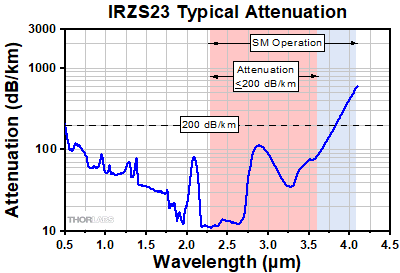 Click to Enlarge
Click to Enlarge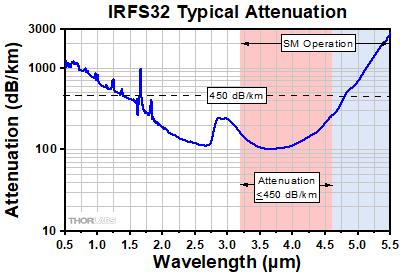 Click to Enlarge
Click to Enlarge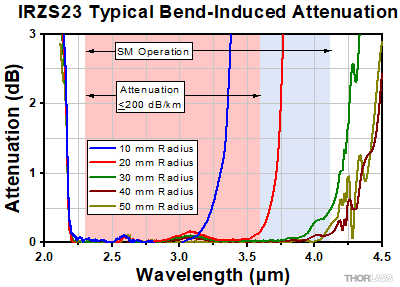 Click to Enlarge
Click to Enlarge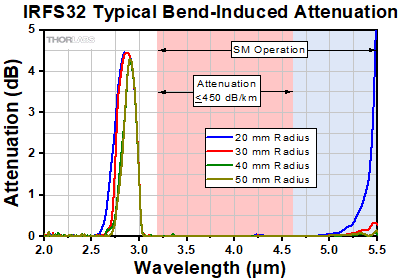 Click to Enlarge
Click to Enlarge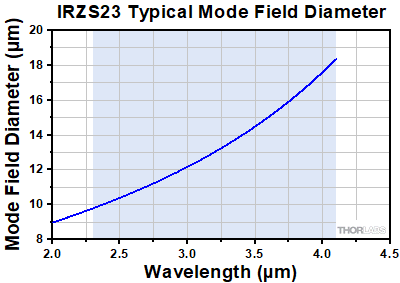 Click to Enlarge
Click to Enlarge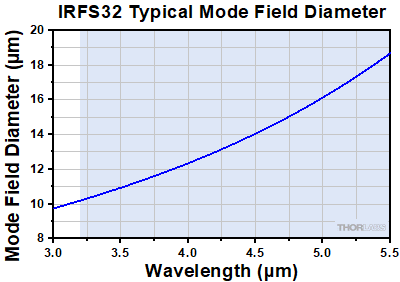 Click to Enlarge
Click to Enlarge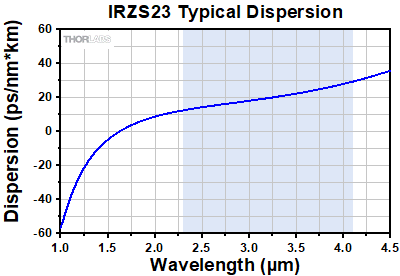 Click to Enlarge
Click to Enlarge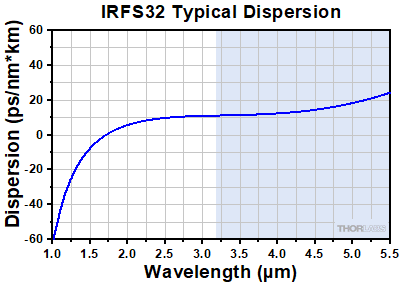 Click to Enlarge
Click to Enlarge Click to Enlarge
Click to Enlarge Click to Enlarge
Click to Enlarge
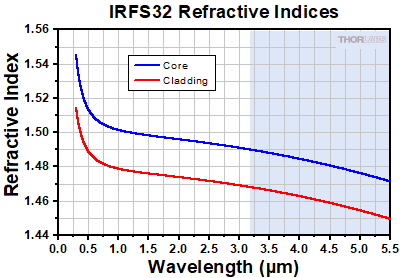
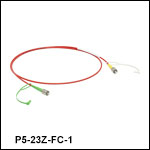
 Zoom
Zoom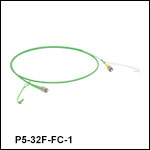
 Single Mode Patch Cables
Single Mode Patch Cables